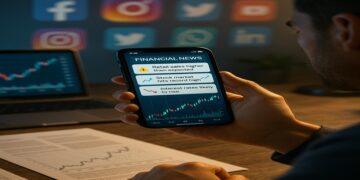How Mobility Applications Are Transforming Access to Financial Information

The Transformation of Financial Management
Accessing financial information has evolved dramatically with the advent of mobile applications. These platforms have not only simplified the way we manage money but have also encouraged a greater understanding of personal finance. This shift is significant, especially as financial literacy becomes increasingly vital for making sound economic decisions.
Real-Time Updates: Staying Informed
Real-time updates are one of the most remarkable features of financial mobile applications. Users can receive instant notifications about their account balances, verifying that they are in control of their financial status at any moment. For instance, when a user makes a purchase on their debit card, they immediately get an alert, enabling them to keep track of spending without having to log into an online banking portal. This constant flow of information helps in preventing overdrafts and managing budgets efficiently.
Moreover, real-time updates extend to investment platforms as well. Imagine you’ve invested in a stock that surges unexpectedly — a mobile app can notify you instantly, allowing you to make timely decisions about buying or selling before the market changes. This feature is crucial in a stock market known for its volatility.
Effective Budgeting Tools
Many financial applications come equipped with budgeting tools that make it easier for individuals to track their spending patterns. For example, apps like Mint or YNAB (You Need A Budget) categorize your purchases, automatically grouping them into spending categories such as groceries, entertainment, and bills. This not only helps users visualize where their money goes but also aids in setting clear financial goals.
Users can create personalized budgets tailored to their income and expenses, enabling them to make informed financial decisions. If a user finds that they are spending too much on dining out, adjustments can be made in real-time to help cut back on unnecessary expenses. As a result, users develop a better understanding of their spending habits and can work towards financial stability.
Investment Accessibility for Everyone
The rise of mobile platforms has democratized investing, allowing even inexperienced individuals to dive into the stock market. With apps like Robinhood or Acorns, everyday investors can buy stocks, ETFs, and cryptocurrencies directly from their devices. This easy access has fostered a new generation of investors who might not have participated in traditional finance due to perceived barriers.
For example, a tech-savvy twenty-something can invest as little as $5 in fractional shares of high-value companies like Amazon or Tesla, previously out of reach for many. The simplicity of these platforms encourages users to learn about investing while actively participating, paving the way for improved financial literacy.
Conclusion: Embracing the Future of Finance
As we navigate this digital age, it is essential to embrace the transformative potential of mobile applications in finance. They provide valuable tools for managing money, understanding investments, and making informed financial decisions. By utilizing these mobile resources, individuals in the United States and beyond can enhance their financial knowledge and inspire others to do the same.
In summary, understanding and adapting to these technological advancements is crucial for anyone looking to thrive in today’s financial landscape. As the technology behind these apps continues to evolve, users can expect even more tools and features designed to make financial management easier and more engaging.
DISCOVER MORE: Click here to learn about the role of networking in tech growth
Empowering Users Through Enhanced Financial Awareness
The rise of mobility applications has significantly empowered users by enhancing their financial awareness. As individuals navigate their financial journeys, these applications offer insights that were previously challenging to access. This newfound visibility encourages better financial habits, ultimately fostering a path towards financial independence.
Customized Alerts and Reminders
One of the standout features of mobile financial applications is the ability to set customized alerts and reminders. These notifications can be tailored to suit individual needs—such as reminding users to pay their bills, alerting them when they are nearing their spending limits, or notifying them of upcoming loan payments. With these reminders, users are less likely to forget important financial deadlines, which helps in avoiding late fees and maintaining a strong credit history.
For example, if a user sets a reminder for their mortgage payment, they can ensure that their payment is made on time every month, maintaining their credit health and avoiding additional stress. Furthermore, some apps allow you to set spending alerts for specific categories, such as dining out or shopping. This proactive approach means users can adjust their behavior and curb unnecessary expenses before they spiral out of control.
Visual Financial Dashboards
Another vital element in these mobile applications is the use of visual financial dashboards. These dashboards present a user-friendly interface that aggregates various financial data into digestible visuals. Typically, they include graphs and charts that illustrate spending patterns, savings over time, and net worth tracking. By providing a visual representation of one’s finances, these dashboards make it easier for users to grasp complex data and identify trends in their financial behaviors.
For instance, a user may discover that they are overspending on subscription services after running a monthly report through their app. This new awareness allows them to reevaluate their subscriptions, potentially saving money and redirecting those funds towards savings or investments. Users are often more motivated to remain engaged with their financial goals when they can see their progress at a glance.
Streamlining Financial Education
Moreover, many financial applications incorporate a focus on financial education, offering resources and articles that help users learn about different aspects of personal finance. Whether it’s understanding credit scores, learning about investment options, or discovering the principles of budgeting, these resources can be invaluable. Users can access educational materials within the app, making it convenient to expand their financial knowledge as they manage their money.
Some applications even feature interactive tools, like quizzes or calculators, to further engage users in their learning process. For instance, an investment calculator can help someone understand how much they can expect to save over time by contributing a certain amount monthly. This hands-on approach not only supports the learning journey but also empowers users to make informed financial decisions.
In conclusion, mobile financial applications have transformed the way individuals approach their finances. By fostering financial awareness through customizable alerts, visual dashboards, and educational resources, these platforms guide users towards smarter financial choices and increased autonomy in their financial lives.
DIVE DEEPER: Click here to discover more
Fostering Financial Inclusion and Accessibility
While financial awareness is crucial, mobility applications have also played a significant role in fostering financial inclusion and accessibility for a broader demographic. Traditionally, accessing financial services often required navigating complex systems that could be overwhelming, particularly for those who are less financially literate or lack experience with banking systems. Mobile applications are changing this landscape by democratizing access to financial information and tools.
Bridging the Urban-Rural Divide
Many applications are specifically designed to address the needs of people in rural or underserved areas, where traditional banking services may be limited. Rural users can access mobile apps to manage their bank accounts, understand credit, and even invest—all from the convenience of their smartphones. By bridging the gap between urban and rural financial services, these applications can help level the playing field.
For instance, a farmer in a remote part of Iowa might use a mobile application to receive real-time market prices for crops, helping them make informed decisions about when to sell. This access to immediate financial information impacts not just individual farmers but also local economies, leading to broader economic growth.
Language Accessibility and User Support
Another way these applications enhance accessibility is by offering multilingual support. Many financial apps now provide information in multiple languages, catering to a diverse user base. This effort ensures that non-native English speakers or those less fluent in the language can still understand financial terms and navigation within the app. By removing language barriers, more people can engage in their financial journeys confidently.
Besides language, many applications also offer user-friendly interfaces that utilize clear icons and simple terminology. This design consideration is essential because it enhances the overall user experience, especially for older adults who might be less tech-savvy. Tutorials and embedded customer support further facilitate understanding, allowing users to seek help during their financial navigation without feeling lost.
Integration with Local Financial Institutions
Moreover, many mobile financial apps have begun to integrate directly with local credit unions and community banks. This integration is significant because it brings essential financial services closer to individuals who may not have access to traditional banks. By allowing users to manage accounts, apply for loans, and receive personalized financial advice all within one application, these tools enhance user experiences and support community-oriented banking.
For example, a user might apply for a loan through a local credit union’s mobile app, which can provide tailored rates and terms based on the user’s financial background. Not only does this ease application processes, but it also fosters trust in local institutions, which are often more amenable to understanding the unique circumstances of their communities.
Peer-to-Peer Lending and Investment Opportunities
Lastly, mobility applications are paving the way for peer-to-peer lending platforms that allow users to borrow or lend money directly without needing an intermediary, such as a bank. These platforms make it easier for people to find funding for personal projects or small businesses, particularly those who might struggle to get approved for traditional loans.
Additionally, users can participate in investment opportunities that were once confined to wealthy individuals or institutional investors. Through mobile apps, anyone can start investing with minimal funds, making stock markets and mutual funds accessible to the average American. This democratization of investment opportunities empowers users to build wealth over time, showcasing how mobility applications transform the access and management of financial information.
DIVE DEEPER: Click here to discover more
Conclusion
In summary, mobility applications are dramatically reshaping how individuals access and manage financial information. By promoting financial inclusion and breaking down barriers, these apps empower users from diverse backgrounds to engage with their finances confidently. They facilitate access to essential services even in rural and underserved areas, demonstrating that technology can bridge significant divides in financial access.
Moreover, the emphasis on multilingual support and user-friendly designs ensures that everyone, regardless of language proficiency or technological savvy, can navigate the financial landscape effectively. This inclusivity fosters a sense of belonging within the financial ecosystem, allowing users to feel competent and empowered in their financial choices.
The integration of local financial institutions further anchors these applications in community needs, ensuring that individuals can rely on trusted resources for their financial journeys. Additionally, the growth of peer-to-peer lending and newfound investment opportunities opens doors for wealth-building that were previously inaccessible to many.
Ultimately, as mobility applications continue to evolve, they not only provide necessary financial information but also nurture a more inclusive and equitable financial environment. By leveraging technology for greater accessibility, these tools are setting a new standard, where every individual can take control of their financial future, leading to stronger and more resilient communities.

Beatriz Johnson is a seasoned financial analyst and writer with a passion for simplifying the complexities of economics and finance. With over a decade of experience in the industry, she specializes in topics like personal finance, investment strategies, and global economic trends. Through her work on Happy Receitas, Beatriz empowers readers to make informed financial decisions and stay ahead in the ever-changing economic landscape.





